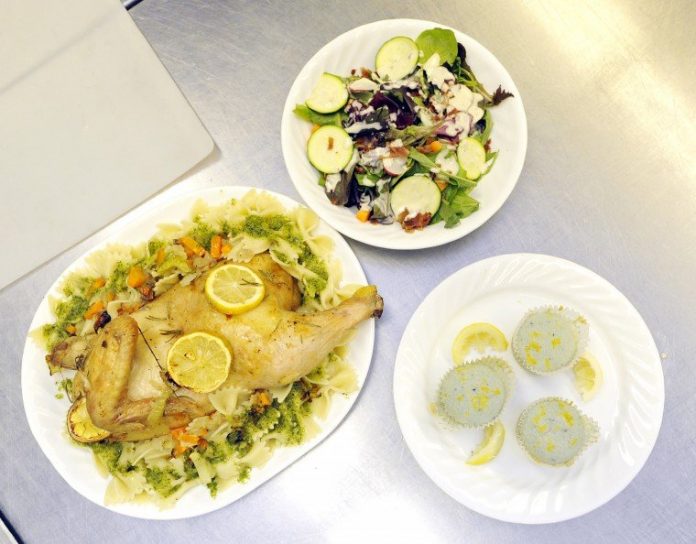
When a teenager disappears into the kitchen to whip up some chow, it’s fair to assume a hassle-free fix is on the menu: Frozen pizza? Easy Mac? Top Ramen? Toasted bagel? Peanut butter straight from the jar?
Fair game.
Which is why watching a group of 17- and 18-year-olds whip up gourmet meals from scratch in less than 90 minutes is like witnessing a small phenomenon.
“You guys are hogging the grill, man,” muses Jerelle Ruloph, hovering over a metal pot bubbling with linguini pasta.
“That’s because you guys are hogging the stove,” volleys Donovan Botello from the other side of the oven, where he flips vegetables with a spatula.
As the only high school culinary curriculum of its caliber in Santa Clara County according to veteran chef instructor Betty Ewing, Gilroy High School’s beginning and advanced cooking classes are something to behold in an age of draconian state budget cuts and program slashing.
With the Gilroy Unified School District shaving approximately $18 million from its spending in the last four years, dwindling state funding for education threatens to chomp away at anything that doesn’t fall under the main courses of reading, writing or arithmetic. At GHS, however – a school often recognized for safeguarding its cache of Regional Occupation Program classes – Ewing praises Principal Marco Sanchez and Vice Principal Stefani Garino as “advocates” for a wide variety of vocation-focused classes.
“We’re not going to have enough chefs out there if we don’t start getting them young,” says Ewing, simultaneously eyeballing senior Charles Walker as he manhandles an entire raw chicken.
Not only that, but “some of these kids are going off to college,” she adds. “They’re going to have to learn how to cook.”
For many of her students, opportunities to experience real-life working environments before venturing into the abyss with nothing but a high school diploma draws the fine line between landing a job and getting looked over. The largest employment opportunity for young adults is in the field of hospitality, Ewing notes.
That’s exactly where senior Michael Shields sees himself headed. With his post-high school road map already charted out (he plans to enroll in the culinary program at Cabrillo College, then transfer to San Jose State University), Shields’ ROP cooking class is as crucial an ingredient to his future as eggs are to soufflés.
“I’ve always wanted to be some type of cook, and this class will help me get there,” he notes, slicing mushrooms and scooping them into a metal bowl.
On this particular day, Shields and eight other advanced cooking students are running around like amateur Bobby Flays and Wolfgang Pucks during Ewing’s “Aluminum Junior Chef Challenge” – something of a hybrid between the popular Food Network shows “Iron Chef” and “Chopped.” After facilitating the challenge for 12 consecutive years while teaching at Los Altos High School, Ewing revived the tradition in 2011 at GHS, where she has taught for five years.
The competition begins with student teams sifting through a smorgasbord of random ingredients, from little smokies to artisan lettuce; puff pastry to feta cheese – then unleashing their foodie fury in a creative race against the clock. Participants are required to concoct an entrée that incorporates a protein, starch and vegetable, in addition to their choice of appetizer or dessert.
Shields and his team members – seniors Cody Froom and Donovan Botello – opt for a dish with mass appeal.
“Honestly, who doesn’t like a kebab?” rations Shields, spearing hunks of pork and pineapple onto wood skewers. “It doesn’t matter what you put on it. It always tastes good.”
Ewing is the formidable ringmaster of this crazy culinary circus, where budding Emerils wearing double-breasted jackets of royal purple dart between sinks and commercial-size refrigerators, or silently concentrate on carving radishes into miniature works of art.
With four decades of experience in the restaurant industry and 15 years of teaching under her belt, Ewing has a decisive knack for dictating quasi-instructions while spotting kitchen disasters a mile before they happen – a skill she wields with the calculated precision of a high-speed food processor.
“These muffins need to go in.”
“You don’t need to heat that up. Cheesecake needs to be cold.”
“Put some pesto in that pasta.”
“Mr. Froom, pull up your pants!”
“Watch your timing!”
“That hair needs to go up.”
“Is that for zesting?”
“Where’s your starch?”
“Stop acting like a child!”
“And this is a salad with what kind of dressing?”
The scene is no different than a professional back-of-the-house operation, with a no-nonsense head chef bellowing reminders and doling constructive criticism. The pace is chaotic and crowded. The air is hot with the aroma of rosemary chicken. People are running into each other.
Students dig it.
“I’ve never been sweatier in my life,” mutters senior Michael Baltar, jogging across the kitchen with a jar of bacon bits for his salad.
In between trips to the refrigerator and grill, Froom explains he got “stuck” in Ewing’s cooking class last year when another class he wanted wasn’t available.
“But I don’t regret it. I loved it, and that’s why I’m in it again,” he said.
Charles Walker, 18, plans on attending Gavilan College and playing basketball next fall, and enjoys getting lost in the dicing, mixing, chopping and artistic presentation of his dishes.
The lanky athlete stood hunched over a metal table, grating delicate strings of lemon zest into paper baking cups filled with blueberry muffin batter.
“It’s nice to get away from all the stress and tests and stuff of my other classes,” he says, shuffling around the kitchen in tall black socks and Nike sandals.
Of the more than 115 students enrolled in Ewing’s culinary classes, many score hands-on experience by catering for district events, drafting professional resumes or participating in a booming side business that sells homemade cookies and cakes to help sustain the culinary program. Ewing’s students even have a fully functioning espresso kiosk at their disposal, where they can develop cappuccino-making skills that will come in handy when it’s time to apply for that barista position at Starbucks or the college campus coffee shop.
Oftentimes, Regional Occupation Classes are the motivators “that keep kids going through emotional and social challenges,” Ewing said. “This keeps them focused, embraced and completely entrenched. You can’t get that in other classes.”
• Gilroy High School: Culinary Arts, Auto Shop, Floral Design, Veterinary Science, Sports Medicine
• Christopher High School: Digital Design and Animation; Advanced Digital Design and Animation, Dance (beginning, intermediate and advanced); Law Enforcement











